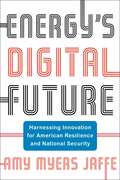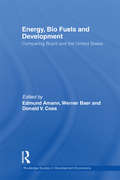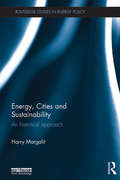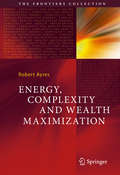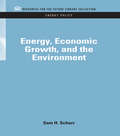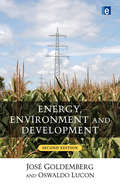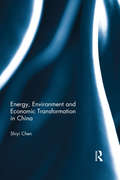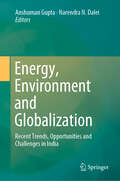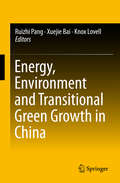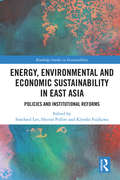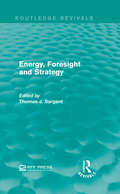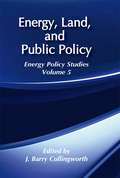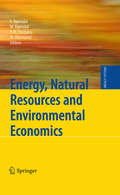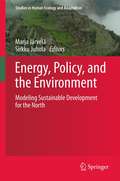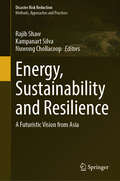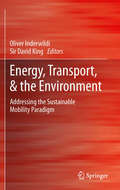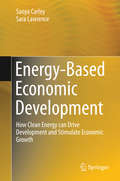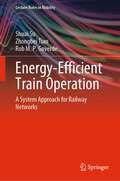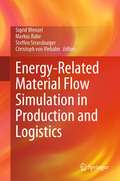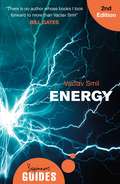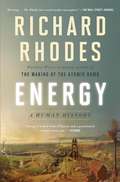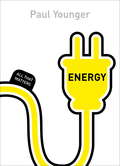- Table View
- List View
Energy's Digital Future: Harnessing Innovation for American Resilience and National Security (Center on Global Energy Policy Series)
by Amy Myers JaffeDisruptive digital technologies are poised to reshape world energy markets. A new wave of industrial innovation, driven by the convergence of automation, artificial intelligence, and big data analytics, is remaking energy and transportation systems in ways that could someday end the age of oil. What are the consequences—not only for the environment and for daily life but also for geopolitics and the international order?Amy Myers Jaffe provides an expert look at the promises and challenges of the future of energy, highlighting what the United States needs to do to maintain its global influence in a post-oil era. She surveys new advances coming to market in on-demand travel services, automation, logistics, energy storage, artificial intelligence, and 3-D printing and explores how this rapid pace of innovation is altering international security dynamics in fundamental ways. As the United States vacillates politically about its energy trajectory, China is proactively striving to become the global frontrunner in a full-scale global energy transformation. In order to maintain its leadership role, Jaffe argues, the United States must embrace the digital revolution and foster American achievement. Bringing together analyses of technological innovation, energy policy, and geopolitics, Energy’s Digital Future gives indispensable insight into the path the United States will need to pursue to ensure its lasting economic competitiveness and national security in a new energy age.
Energy, Bio Fuels and Development: Comparing Brazil and the United States (Routledge Studies In Development Economics Ser. #87)
by Werner Baer Edited by Edmund Amann Donald V. CoesThis collection examines the important and topical issue of the economic, social and environmental implications of concerted attempts to diversify energy sources away from fossil fuels. The book expertly examines this issue by focussing on the contrasting experiences of two major economies; one developed, and the other a rapidly expanding, emerging market. Energy, Bio Fuels and Development evaluates the experience of Brazil, with elements of that of the US highlighted for the purpose of comparison. A key area of concern surrounds the causes and consequences of the contrasting routes to biofuel production represented by sugar cane (in Brazil) and corn (in the US). The book also places the recent biofuels drive in perspective by discussing the broader energy policy context. The book shows the complexity and interdependence of the issues involved in moving a society reliant on non-renewable energy sources to one based on alternative sources of energy. The key conclusion to emerge is that Brazil, in pursuing a flexible mix of fossil fuels and bio-fuels, has greatly diminished its exposure to exogenous energy shocks. The US experience – in particular its development of corn-based ethanol – has been more problematic, though by no means without successes. It is argued that bio fuels should not be seen as a panacea. There are clear limits to the efficiency and cost effectiveness of current biofuel production technologies while there remain concerns surrounding potentially adverse effects on food production and rural livelihoods. This book should be an excellent resource for students focussing on economic development, particularly in the areas of energy, biofuels, rural development and food supply.
Energy, Cities and Sustainability: An historical approach (Routledge Studies in Energy Policy)
by Harry MargalitAccording to some estimates, humanity has now passed the point at which city dwellers outnumber country dwellers. This simple fact encapsulates a multitude of historical trends and contentions, not the least being "is this sustainable"? Energy, Cities and Sustainability aims to illuminate this question by tracing the evolution of the modern city, the energy sources that power it and the motivations behind increasing urbanisation. The book examines changing energy use across history, analysing the origins and significance of the Industrial Revolution to reveal how the modern city came into being. Transport, population size, housing, electricity use and growing consumption are each discussed, showing how the cultural aspects of energy use have influenced urban form in the developed world and developing countries. Finally, in contemplating the future, it is considered whether this model of modern urban life is sustainable. This book is a valuable resource for researchers, academics and policy-makers in the areas of planning, energy policy and environment and sustainability.
Energy, Complexity and Wealth Maximization
by Robert AyresThis book describes the evolution and mechanisms of natural wealth creation. The author explains how natural wealth consists of complex physical structures of condensed ("frozen") energy and what the key requirements for wealth creation are, namely a change agent, a selection mechanism and a life-extending mechanism. He uses elements from multiple disciplines, from physics to biology to economics to illustrate this. Human wealth is ultimately based on natural wealth, as materials transform into useful artifacts, and as useful information is transmitted by those artifacts when activated by energy. The question is if the new immaterial wealth of ideas of the knowledge economy can replace depleted natural wealth. This book reveals the vital challenge for economic and political leaders to explore how knowledge and natural capital, energy in particular, can interact to power the human wealth engine in the future.
Energy, Economic Growth, and the Environment (RFF Energy Policy Set)
by Sam H. SchurrAuthors with widely different perspectives consider two important social objectives: assuring future energy supplies and protecting the natural environment. Contributors include Kenneth Boulding, Glenn Seaborg, and Barry Commoner. Particularly useful to students and interested non-specialists. Originally published in 1972
Energy, Environment and Development
by Jose Goldemberg Oswaldo LuconThe relationship between energy and the environment has been the basis of many studies over the years, as has the relationship between energy and development, yet both of these approaches may produce distortions. In the first edition of this book, Professor Goldemberg pioneered the study of all three elements in relation to one another. With contributions from Oswaldo Lucon, this second edition has been expanded and updated to cover how energy is related to the major challenges of sustainability faced by the world today. The book starts by conceptualizing energy, and then relates it to human activities, to existing natural resources and to development indicators. It then covers the main environmental problems, their causes and possible solutions. Disaggregating national populations by income and by how different income groups consume energy, the authors identify the differences between local, regional and global environmental impacts, and can thus ascertain who is responsible for them. Finally, they discuss general and specific policies to promote sustainable development in energy. New coverage is included of today's pressing issues, including security, environmental impact assessment and future climate change/renewable energy regimes. The authors also cover all major new international agreements and technological developments. Energy, Environment and Development is the result of many years of study and practical experience in policy formulation, discussion and implementation in these fields by the authors. Written in a technical yet accessible style, the book is aimed at students on a range of courses, as well as non-energy specialists who desire an overview of recent thought in the area.
Energy, Environment and Economic Transformation in China
by Shiyi ChenChina has achieved rapid economic growth since the market-oriented reform in 1978 and became the second largest economy in the world in 2010. However, the growth model in China is still extensive in nature and may be characterized with high energy consumption and heavy environmental pollutions etc. In fact, China has successively become the largest carbon emitter since 2007 and the largest energy consumer since 2009 in the world. This book endeavors to analyze whether such energy driven and environment restricted economic growth can be sustainable in China in the long run. The book describes the basic situations of energy consumption and environmental pollution in China from the dimensions of industries, regions and energy-types. It also introduces the evolution of energy and environmental policies implemented in China. In particular, this book makes use of the environmental activity analysis model to assess the sustainable transformation of economic model in Chinese industries and regions. This model captures the negative externalities of pollutants and estimates the environmental total factor productivity accurately. The possibilities of win-win development and double dividend are also forecasted. This book proposes new methods to measure the environmental total factor productivity, evaluate the process of low carbon transformation, quantify the structural bonus, estimate the abating cost and forecast the win-win development and so on. Researchers may find these methodologies useful for measuring other pollutants and for analysis in other countries.
Energy, Environment and Globalization: Recent Trends, Opportunities and Challenges in India
by Anshuman Gupta Narendra N. DaleiThis book analyzes contemporary issues relating to energy, environment, and globalization in the Indian context. As a signatory to the Paris climate accord, India has reiterated its commitment to taking strong and positive steps toward climate change mitigation. However, as one of the fastest growing economies in the world, it is battling the effects of a steep rise in fossil fuel usage and pollution. Further, increasing globalization is leading to greater economic activity and production, resulting in additional energy use, which has a negative effect on the environment. The book argues that globalization need not have only a negative environmental impact; it can also have positive impact through the importation of environmentally sound technologies and implementing global compliance standards. The book is divided into three sections: The energy section discusses issues relating to the status of Indian natural gas market and the need for developing an efficient gas market in India; the economics and politics of sustainable energy in India; the challenges of thermal power and significance of clean thermal power generation in India; environmental and policy issues concerning energy use in urban India; the importance of energy use in developing Human Development Index (HDI); and issues relating to renewable energy in India. The environment section then examines topics such as the impact of global warming on local weather by examining the frequency of extreme weather events such as drought and floods, and their impact on farming activities in the Indian state of Odisha; the importance of according the economic value to environmentally significant things like national park , mangroves, etc. for sustainable development; the role of environmental accounting for ecological sustainability and ecotourism; and environmental concerns increasingly gaining traction among the corporate sector for their long-run benefits . Lastly, the third section addresses issues relating to the challenges and opportunities of globalization, such as the interface between globalization and environment; managing India’s business interest in proposing new Bilateral Investment Treaty (BIT); the challenges being faced by Indian exports and their revival; and making Indian SMEs competitive. As such, it is an invaluable resource for policymakers, researchers, practitioners and students in the field of energy, environment and trade economics.
Energy, Environment and Sustainable Development
by Mohammad Aslam Uqaili Khanji HarijanNew information and strategies for managing the energy crisis from the perspective of growing economies are presented. Numerous case studies illustrate the particular challenges that developing countries, many of which are faced with insufficient resources, encounter. As a result, many unique strategies to the problems of energy management an conservation, environmental engineering, clean technologies, biological and chemical waste treatment and waste management have been developed.
Energy, Environment and Transitional Green Growth in China
by Ruizhi Pang Xuejie Bai Knox LovellThis book discusses energy use and its environmental footprint in China, as well as issues concerning the transitional green growth of its economy, a subject of great importance in light of China’s size and its impressive record of economic growth. The book includes expert overviews and empirical studies prepared by internationally recognized experts in the field. The empirical techniques utilized by the contributors include econometrics, mathematical programming, and index numbers. The book will provide readers a deeper understanding of the energy and environmental issues China now faces during its transitional growth period, and of the strategies available for resolving these issues. The 2016 Asia-Pacific Productivity Conference, held in Nankai University, Tianjin China from July 7-10, was organized by Nankai University’s College of Economic and Social Development (CESD) in collaboration with the School of Economics Nankai University and Collaborative Innovation Center for China Economy. The primary objective of the event was to highlight the latest developments in efficiency and productivity research.
Energy, Environmental and Economic Sustainability in East Asia: Policies and Institutional Reforms (Routledge Studies in Sustainability)
by Hector Pollitt Soocheol Lee Kiyoshi FujikawaThis book looks at institutional reforms for the use of energy, water and resources toward a sustainable future in East Asia. The book argues that developments in the East Asian region are critical to global sustainability and acknowledges that there is an increasing degree of mutual reliance among countries in East Asia – primarily China, Japan, Korea and Taiwan. It analyzes environmental impacts stemming from the use of energy, water and mineral resources via economic development in East Asia in the medium to long term (through 2050) through theoretical and empirical modelling. The book also evaluates the ripple effects of environmental and resource policies on each country’s economy and clarifies the direction of institutional reform in energy systems, resources and water use for a sustainable future.
Energy, Foresight and Strategy (Routledge Revivals)
by Thomas J. SargentThe essays in Energy, Foresight and Strategy apply rational expectation theory to various energy markets with the intention of discussing issues relevant to analysis and decision making in the whole of the energy field. Originally published in 1985, issues explored include oil exportation, energy prices and embargoes, both focussing on how past regulation has created issues in the market at the time of publication as well as creating models to ascertain the futures of various energy resources. This title will be of interest to students of Environmental Studies and Economics.
Energy, Land and Public Policy: Energy Policy Studies (Energy and Environmental Policy Series #5)
by J. Barry CullingworthThe development of alternative forms of energy supply since the mid-1970s has brought with it a range of new issues and concerns, ranging from nuclear waste disposal to land use planning for energy efficiency. This latest volume in the acclaimed Energy Policy Studies series brings together an interdisciplinary group of researchers to examine the relationship between energy and planning policy, with emphasis on urban and regional impacts.Like other volumes in the series, the articles included focus on the social, political, and economic dimensions of energy technology, resources, and use. The emphasis on issues of technological scale, resource allocation, environmental impact and quality, and urban and regional studies makes this a unique contribution to the literature.Contents: "Creating Land-Energy Transitions," by Andrew F. Huston, U.S. Department of Housing and Urban Development; "Land Use Planning for Energy Efficiency," by Susan E. Owens, Cambridge University; "Nuclear Waste Landscapes," by Barry Solomon, U.S. Energy Information Administration; "Economic Development, Growth and Land Use Planning in Oil and Gas Producing Regions," by Robert L. Mansell, University of Calgary; "The Land Use Focus of Energy Impacts," by M. J. Pasqualetti, Arizona State University; "Energy Use and Land Use," by Stephen Lonergan, McMaster University; and a concluding essay by J. Barry Cullingworth, University of Delaware.
Energy, Natural Resources and Environmental Economics
by Panos M. Pardalos Endre Bjørndal Mette Bjørndal Mikael RönnqvistThe book consists of a collection of articles (survey and research) describing the area of energy, natural resources and environmental economics. The contents of the book is divided into four sections. The first part considers petroleum and natural gas applications, taking up topics ranging from the management of incomes and reserves to market modeling and value chain optimization. The second and most extensive part studies applications from electricity markets, including analyses of marked prices, risk management, various optimization problems, electricity market design and regulation. The third part describes different applications in logistics and management of natural resources. Finally, the fourth part covers more general problems and methods arising within the area. The volume contains many examples from Nordic countries where there is knowledge and experience in managing natural resources.
Energy, Policy, and the Environment
by Sirkku Juhola Marja JärveläThis book sets the questions of energy and the environment in the North in the global context and further addresses historical developments, views on energy taxation and tariffs, and effects of EU energy policy. Climate change appears more frequently than ever on the top of global and national policy agendas. In the current situation traditional environmental concern and environmental policy may not suffice in the face of the global challenge as manifested by climate change and the depletion of fossil energy resources. But as new data comes to light, new energy policies and changes in economic structures are crucial for putting into action global climate policy. Crucial tasks in environmental policy are the sustainable utilisation of natural resources and the conservation of natural and human-made habitats. One of the areas of the world where this comes into play the most is in the Nordic countries. Northern societies are predominantly high tech, high consumption and high energy supply societies. And with the transition from older energy sources (wood for heating and stream water for power production) to newer ones (oil and nuclear energy) discussions on the environmental impact have led to public and corporate action. The Northern countries have been at the forefront in finding sustainable alternatives to solve conflicts arising from the rise in energy needs. However, these countries have taken different pathways with different policies in attempting to achieve this. As the needs and concerns from climate change arise, a Northern dimension, involving policies that contrast to European and global trends, emerges. Energy, Policy, and the Environment: Modeling Sustainable Development for the North explores that dimension.
Energy, Sustainability and Resilience: A Futuristic Vision from Asia (Disaster Risk Reduction)
by Rajib Shaw Kampanart Silva Nuwong ChollacoopThis book analyzes the experiences of energy, sustainability and resilience issues from different Asian countries and puts forward a futuristic vision of an energy sector for sustained development. Energy is at the core of development, but in energy generation, there are severe environmental implications in many cases. This clearly affects development and causes significant challenges to sustainability. Climate change and disasters have an effect on energy infrastructures and also make significant impacts on humans in terms of both shocks and stresses. Therefore, it is extremely important to understand the linkage of energy, sustainability and resilience. Asia is a hotspot of climate change and disasters, suffering from severe damages to the energy infrastructure of the countries there. At the same time, being a core of world development trajectories, Asia produces and consumes more energy in different sectors than any other part of the world. Also, however, Asia serves as a core region of innovative ideas in energy and related sectors.
Energy, Trade and Finance in Asia: A Political and Economic Analysis (Perspectives in Economic and Social History #15)
by Tai Wei Lim Justin DarginThis study offers a vital reappraisal of the trade relationship between north-east Asia and the Gulf. Writing from a non-western standpoint, Dargin and Lim make a compelling case for how these regions became economically integrated in the wake of the 1973 oil crisis.
Energy, Transport, & the Environment
by Oliver Inderwildi Sir David KingSustainable mobility is a highly complex problem as it is affected by the interactions between socio-economic, environmental, technological and political issues. Energy, Transport, & the Environment: Addressing the Sustainable Mobility Paradigm brings together leading figures from business, academia and governments to address the challenges and opportunities involved in working towards sustainable mobility. Key thinkers and decision makers approach topics and debates including: energy security and resource scarcity greenhouse gas and pollutant emissions urban planning, transport systems and their management governance and finance of transformation ·the threats of terrorism and climate change to our transport systems. Introduced by a preface from U.S. Secretary of Energy, Steven Chu and an outline by the editors, Dr Oliver Inderwildi and Sir David King, Energy, Transport, & the Environment is divided into six sections. These sections address and explore the challenges and opportunities for energy supply, road transport, urban mobility, aviation, sea and rail, as well as finance and economics in transport. Possible solutions, ranging from alternative fuels to advanced urban planning and policy levers, will be examined in order to deepen the understanding of currently proposed solutions within the political realities of the dominating economic areas. The result of this detailed investigation is an integrated view of sustainable transport for both people and freight, making Energy, Transport, & the Environment key reading for researchers, decision makers and policy experts across the public and private sectors.
Energy, Transport, & the Environment: Addressing the Sustainable Mobility Paradigm
by Oliver Inderwildi Sir David KingSustainable mobility is a highly complex problem as it is affected by the interactions between socio-economic, environmental, technological and political issues. Energy, Transport, & the Environment: Addressing the Sustainable Mobility Paradigm brings together leading figures from business, academia and governments to address the challenges and opportunities involved in working towards sustainable mobility. Key thinkers and decision makers approach topics and debates including: energy security and resource scarcity greenhouse gas and pollutant emissions urban planning, transport systems and their management governance and finance of transformation·the threats of terrorism and climate change to our transport systems. Introduced by a preface from U.S. Secretary of Energy, Steven Chu and an outline by the editors, Dr Oliver Inderwildi and Sir David King, Energy, Transport, & the Environment is divided into six sections. These sections address and explore the challenges and opportunities for energy supply, road transport, urban mobility, aviation, sea and rail, as well as finance and economics in transport. Possible solutions, ranging from alternative fuels to advanced urban planning and policy levers, will be examined in order to deepen the understanding of currently proposed solutions within the political realities of the dominating economic areas. The result of this detailed investigation is an integrated view of sustainable transport for both people and freight, making Energy, Transport, & the Environment key reading for researchers, decision makers and policy experts across the public and private sectors.
Energy-Based Economic Development
by Sara Lawrence Sanya CarleyEnergy is becoming a prominent driver of economic development. Each year, billions of dollars are invested around the world by the public and private sectors in low-emissions energy development and energy efficiency planning. Energy-based economic development (EBED) is a domain that seizes the opportunities inherent in clean energy development to drive innovation and generate economic growth. Energy-based economic development: How clean energy can drive development and stimulate economic growth delivers working definitions, common approaches, descriptions of supportive policy mechanisms, and suggested metrics for evaluation. The book offers a unified framework for EBED that is supported by examples and leaves readers better equipped to design, plan, and implement EBED initiatives. Case studies illustrate how national and subnational initiatives adopt to a locale's energy asset base, energy and economic development needs, and the context in which the initiative operates. Descriptions of the energy projects supported by the American Recovery and Reinvestment Act offer insights about what worked and what did not and suggest ways in which governments can be better prepared to manage EBED projects in the future. This book provides the tools necessary to work toward simultaneous energy and economic development goals and facilitates discussion for an advanced policy agenda of energy efficiency, energy diversification, innovation-led economic growth, and job creation.
Energy-Efficient Train Operation: A System Approach for Railway Networks (Lecture Notes in Mobility)
by Shuai Su Zhongbei Tian Rob M. GoverdeThis book is closely related to the energy conservation problem of rail transport systems, focusing on reducing the energy consumption of train operation. The system process of train operation is analyzed and the relationship between train operation and energy consumption is introduced. The fundamental theories, modelling and application of technologies for energy-efficient train driving are presented, discussing timely topics such as energy-efficient train control and timetabling, integrated timetabling and regenerative braking, and maximizing regenerated energy usage with energy storage systems. In addition, the modelling and application of a traction power simulation platform is introduced, to calculate the detailed energy flow over a railway network. The book is enriched with a set of practical examples to illustrate the performance of the proposed methods in improving energy efficiency of both urban and long-distance trains. Overall, the book provides a timely guide to professionals in the railway industry, and to researchers and graduate students in transport, electrical and control engineering.
Energy-Related Material Flow Simulation in Production and Logistics
by Markus Rabe Sigrid Wenzel Steffen Strassburger Christoph Von ViebahnThis book provides for the first time an overview on the current approaches and applications of energy aspects in production and logistics by the use of simulation techniques. During the last decade, the importance of energy in the material flow processes has become more and more important. The pressure to reduce the environmental footprint of production and logistics systems will even intensify in future. Therefore, enterprises have started to integrate the use of energy into their planning processes much more than before, even designing feedback loops, e.g., from energy control to production control. This receives additional attention with the increasing use of renewable, but less reliable, energy sources. Care must be taken to establish processes that aim to use energy when it is available. As an example, many industrial processes like melting or coating have significant energy demands, but could vary the point of time of its consumption within specific limits, leading to a very high complexity. It discusses the construction and application of energy-specific performance indicators and analyzes the input information that needs to be acquired before implementing suitable models. On this basis, concrete technical solutions are introduced.
Energy: A Beginner's Guide (Beginner's Guides)
by Vaclav SmilWith one famous equation, E=mc2, Einstein proved all matter can be described as energy. It is everywhere and it is everything. In this newly updated and engaging introduction, renowned scientist Vaclav Smil explores energy in all its facets – from the inner workings of the human body to what we eat, the car we drive and the race for more efficient and eco-friendly fuels. Energy: A Beginner's Guide highlights the importance of energy in both past and present societies, by shedding light on the science behind global warming and efforts to prevent it, and by revealing how our daily decisions affect energy consumption. Whether you're looking for dinner table conversation or to further your own understanding, this book will amaze and inform, uncovering the truths and exposing the myths behind one of the most important concepts in our universe.
Energy: A Human History
by Richard RhodesPulitzer Prize- and National Book Award-winning author Richard Rhodes reveals the fascinating history behind energy transitions over time—wood to coal to oil to electricity and beyond.People have lived and died, businesses have prospered and failed, and nations have risen to world power and declined, all over energy challenges. Ultimately, the history of these challenges tells the story of humanity itself. Through an unforgettable cast of characters, Pulitzer Prize-winning author Richard Rhodes explains how wood gave way to coal and coal made room for oil, as we now turn to natural gas, nuclear power, and renewable energy. Rhodes looks back on five centuries of progress, through such influential figures as Queen Elizabeth I, King James I, Benjamin Franklin, Herman Melville, John D. Rockefeller, and Henry Ford. In Energy, Rhodes highlights the successes and failures that led to each breakthrough in energy production; from animal and waterpower to the steam engine, from internal-combustion to the electric motor. He addresses how we learned from such challenges, mastered their transitions, and capitalized on their opportunities. Rhodes also looks at the current energy landscape, with a focus on how wind energy is competing for dominance with cast supplies of coal and natural gas. He also addresses the specter of global warming, and a population hurtling towards ten billion by 2100. Human beings have confronted the problem of how to draw life from raw material since the beginning of time. Each invention, each discovery, each adaptation brought further challenges, and through such transformations, we arrived at where we are today. In Rhodes’s singular style, Energy details how this knowledge of our history can inform our way tomorrow.
Energy: All That Matters
by Paul L. YoungerEnergy is probably the defining topic of our age. Uncertainty over the long-term availability of some hydrocarbons and nuclear fuels are increasingly prompting volatility in energy prices on world markets. Meanwhile, no serious scientist doubts that the unabated atmospheric emissions of carbon dioxide associated with traditional forms of energy use are (at very least) exacerbating natural variations in climate in undesirable ways. For either reason or both, few commentators of any stature argue that "do nothing" is a credible option in the world of energy management. The technical challenges are legion; yet energy is just as much a socio-economic issue. Surprisingly, there are no authoritative books giving an overall introduction to energy for a general readership, offering adequate coverage of the scientific, engineering, environmental, social and economic dimensions in a single, reasonably-sized and easily-readable volume. The book proposed here seeks to fill that gap.
